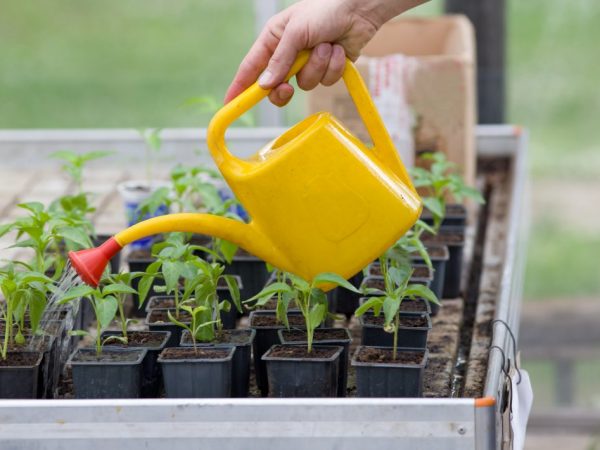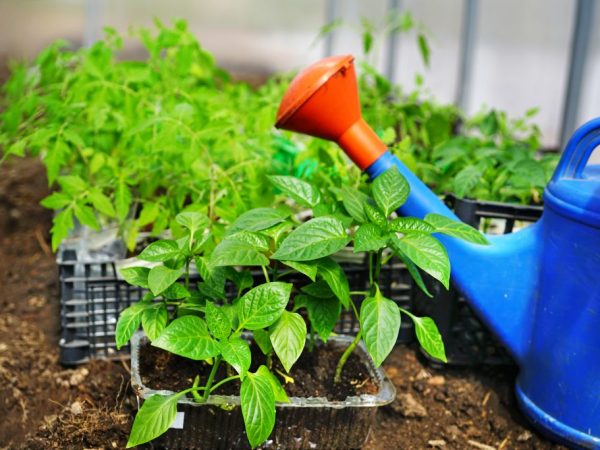Rules for watering pepper seedlings
Pepper is a moisture-loving plant, therefore it needs frequent watering. Proper watering of pepper seedlings is the key to good growth of vegetable crops and excellent yields.

Rules for watering pepper seedlings
Watering rules
Watering pepper seedlings should be done in moderation. The soil should always be moist. It should not dry out and be waterlogged. For proper watering, several basic characteristics must be considered:
- drainage;
- frequency;
- water quality;
- nutrients .
It is also necessary to consider the suitability of the premises for growing crops. Plants should not be exposed to direct sunlight. In a dry and hot room, watering of pepper seedlings needs to be increased.
Seedlings do not like too humid air. The room must be ventilated.
Drainage
The presence of drainage in pepper seedlings allows water not to stagnate and prevents root rot.
There should be drainage holes at the bottom of the planting container. They will remove excess moisture from the soil.
Drainage material can be different:
- crushed stone;
- expanded clay;
- coarse sand;
- finely crushed foam.
The thickness of the drain should not exceed 1-2 cm. Well-fertilized soil can be laid on it.
Water quality
The water should be warm, settled, clean.
Requirements for water condition:
- Temperature. The optimum is 25-28 ° C. The vegetable doesn't like cold water. He can get sick and rot. The water should not be hot. The seedlings can be scalded.
- Rigidity. Water can be melt or rainwater. It can be kept in a separate container for 1-2 days. If the water is from the tap, it must be boiled before use.
- The volume should be about 5 liters per 1 m2 of seedling area. It needs to be adjusted independently, based on the condition of the soil. If it is wet, not waterlogged, then watering may not be carried out at all. If dry, add 5-6 liters of liquid.
Watering pepper seedlings should be done carefully. It is important that no water gets on the leaves. It should immediately go to the root.
Watering with fertilizers

We dilute fertilizers in water
During the first stage of growth (before emergence), watering can be combined with groundbait.
Natural ways
The first option - can be poured with water, settled together with the shell of chicken eggs. This requires:
- Pour 3-4 eggs into eggshells.
- Place them in a 3 liter bottle.
- To boil water.
- Pour the shells with this boiling water.
- Let it brew for 3-4 days in a dark room.
- Strain.
- The filtered water can be used.
During sedimentation, the shell will give all its useful microelements to the liquid: calcium, potassium, magnesium. They will stimulate root development.
For the second option for feeding sweet peppers at home, use ordinary tea. 100 g of used tea leaves are poured into 2 liters of boiling water. The tea should cool down and infuse for 2-3 hours. Then strain the tincture, discard the tea, and pour the decanted water.
Other drugs
Stronger fertilizers can be applied:
- Nitrofoska. In 10 liters of water, 1 tbsp is diluted. nitrophosphate.
- Cow droppings. Use 1 tbsp.l per 10 l of water.
- Biofertilizers. These include "Ideal", "Camomile", "Planta" and others.
- Bird droppings. It will take 2 tbsp. spoons on a bucket.
Before use, bird droppings are infused in water in a ratio of 1:20 in a large container. The duration of the sludge is 2-3 hours. More can be defended, but a pungent fermentation smell may appear.
After picking, you can water the plants with Planta and Kemir solution. After that, it is allowed to fertilize the sprouts only after 1 week.
It is enough to water the plant with groundbait 2-3 times. It must be alternated with ordinary water.
Watering stages

Follow your watering schedule
It is necessary to water the plants with a certain frequency. It will depend on the stage of growth of the pepper seedlings.
Watering stages:
- During landing. When planting seeds, it is necessary to moisten the soil. The jet should not wash off the soil from the plants. It is best to leave about 2 cm free of the ground to the end of the sides.
- The first watering can be done together with the disinfection procedure. The soil is watered with a hot 3% solution of potassium permanganate (3 g per 100 ml). Leave the treated soil open for 12 hours.
- Before germination. Do not swamp the soil before sprouting. The seeds may not hatch and rot. Therefore, before the first shoots appear, the procedure is carried out once every 2-3 days.
- After planting, the soil can be covered with foil. This will help reduce the amount of watering. It will trap moisture from evaporation and create a greenhouse effect. It is necessary to constantly monitor the condition of the soil under the film. It shouldn't dry out. If there is a film, you can water it once every 7-8 days.
- After the first shoots appear. As soon as the first shoots have appeared, the film must be removed. Now pepper seedlings should be watered regularly every day.
- Watering pepper seedlings is necessary in the morning. It is undesirable to do this in the evening. At night, moisture evaporates from the soil and remains on the bottom of the sheets. Additional moisture will increase the risk of leaf rot.
- During a dive. Pepper is difficult to take root in a new place. You can avoid picking if you choose the right container and the distance between the seeds. If you still need it, remember - it is necessary to remove the shoots from the moist soil. Dry soil will fall off the root and can damage the structure of the entire root system.
Water the plants 2 hours before picking. After the excess moisture has been absorbed, you can gently pull out the stem.
Measures to save the plant from waterlogging
Waterlogging can lead to a root disease called black leg. If all the rules are followed, the risk of illness will be low. But if, nevertheless, this happened, a number of measures must be taken immediately:
- stop watering;
- ensure good air exchange between plants;
- if necessary, carry out a pick;
- sprinkle the soil with cooled calcined sand;
- ash can be used instead of sand.
Disease from one plant can quickly spread to others. Therefore, if the measures taken do not help, it is better to remove diseased plants.
Watering for disease prevention
Before planting in the ground, preventive measures against pests are also carried out. Seedlings can be sprayed with one of the recommended tinctures:
- Garlic tincture. 220 g of garlic, ground in a meat grinder, are poured into 0.5 liters of water. Let it brew for 5 days and then decant. For spraying, this tincture is diluted with water 25 ml per 1 liter.
- Tincture of coniferous extract. You need to take 1 kg of needles per 10 liters of warm water. The tincture is kept in a dark room for about 7 days. They are filtering. Spray with a solution in a ratio of 1: 5.
- Tincture of calendula. 100 g of calendula is poured with hot water 1: 1. The tincture is allowed to stand for 2 days. The strained infusion can be used for spraying
- Marigold tincture. The method of preparation is similar to a decoction of calendula.
Spray with infusions of the desired one a week before planting in open ground. You can use the tincture in other cases, but not more often than 1 time in 10 days.
Also, like a diseased bush, seedlings with pests must be isolated from other plantings. But if the young bushes are struck by a fungal disease, the amount of watering should be reduced by 2 times or stopped altogether for 10 days.
Conclusion
Well-watered, but not waterlogged soil is a guarantee of the development of a good and healthy plant in the future. If the conditions for watering pepper seedlings are met, the roots of the sprouts will grow strong, and the plant itself will subsequently give an excellent harvest.


